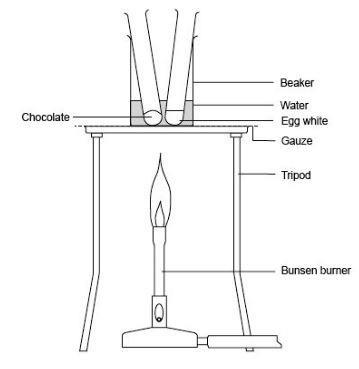Use this practical to introduce students to physical and chemical changes and the safe use of Bunsen burners
In this simple experiment, students use a Bunsen burner and water bath to investigate the different effects of heat on chocolate and egg white. The practical provides a clear introduction to physical and chemical changes, and can be used to ensure students learn how to use Bunsen burners safely.
This straightforward, if somewhat messy, experiment should take no more than 30 minutes.
Equipment
Apparatus
- Eye protection
- Test tubes, x2 (see note 6 below)
- Beaker, 250 cm3
- Bunsen burner
- Heat resistant mat
- Tripod
- Gauze
- Test tube rack
- Test tube holder
Chemicals
- Chocolate, a few grams
- Egg albumen (egg white), about 4 cm3
Health, safety and technical notes
- Read our standard health and safety guidance.
- Wear eye protection throughout. Do not sit down while heating the beaker or handling the hot test tubes.
- Do not taste foods in a laboratory. The food or the apparatus may be contaminated. This ‘no tasting’ rule should be strictly enforced.
- Chocolate – cooking chocolate is the best type of chocolate for this experiment (other types melt too slowly). The chocolate should be grated and pre-loaded into a test tube for each working group, sufficient to give about a 2 cm depth of molten chocolate when heated – this may require trials to establish the correct amount of grated chocolate.
- Egg albumen – use eggs with the ‘lion brand’ stamp’ as these should be salmonella free. The egg white needs to be separated from the yolks of sufficient eggs to provide enough for about 4 cm3 of egg white for each working group. The egg white should then be pre-loaded into a test tube for each working group.
- At the end of the lesson, the students can be asked to hand back their test tubes with the contents still inside, as recovery and cleaning may cause less mess than leaving it to the students. The chocolate is best removed by re-melting and pouring out of the tubes.
Procedure

- Add cold water to the beaker until it is about one-third full, and place it on the tripod and gauze.
- Place a test tube with egg white and a test tube with chocolate in the beaker.
- Heat the beaker of water with the test tubes carefully until the water in the beaker boils. Allow the water to boil gently for about 5 minutes.
- Watch what happens to the egg white and the chocolate in the tubes while they are being heated.
- Turn off the Bunsen burner and use the test tube holder to transfer the tubes to the rack to cool.
- Watch what happens to the egg white and the chocolate in the tubes as they cool.
Teaching notes
This experiment is appropriate for classes at an early stage in their science education, so students are likely to be fairly inexperienced in the safe and skillful use of the Bunsen burner. This is therefore a good opportunity to develop their ability to use the Bunsen burner and emphasis safety points, such as standing up when doing experiments that involve heating.
The main purpose of the experiment is of course to introduce physical and chemical change, and the associated ideas of reversible and non-reversible changes. The chemical change in the egg white should take no more than 5 minutes once the water is boiling, and grated cooking chocolate should melt in about the same time. Many children will have met this in primary school.
On cooling, the chocolate will of course solidify to a solid mass, and students may be distracted by the change of form from the grated material at the start. If so, the technician could be asked to pre-melt the chocolate in the tubes and allow it to solidify again before the lesson, but note that it will then take longer for the chocolate to melt in the experiment.
Further information
The Exploratorium provides a discussion of the nature of the chemical changes involved in cooking eggs, suitable for teacher background information.
Additional information
This is a resource from the Practical Chemistry project, developed by the Nuffield Foundation and the Royal Society of Chemistry.
Practical Chemistry activities accompany Practical Physics and Practical Biology.
© Nuffield Foundation and the Royal Society of Chemistry


















No comments yet